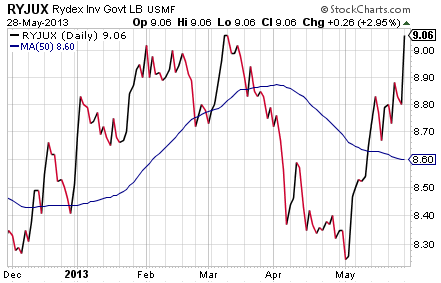Hedge Your Bets With Bond Funds
Post on: 19 Май, 2015 No Comment

Hedge Your Bets With Bond Funds
Escalating sovereign debt problems in Europe plus the recent weak U.S. employment reports have raised fears that we could be headed into recession again.
Should that scenario play out, stocks are likely to head down, but bondholders will probably still make money. However, individual bonds are not as easily traded as stocks so it makes more sense for individual investors to buy funds that invest in bonds rather than the bonds themselves.
If you believe that the economy is headed down, or if you simply want to hedge your bets, here are four funds that, in my view, would be suitable. Two are exchange-traded-funds (ETFs) and two are closed-end-funds.
ETFs are funds that generally track preset indexes while closed-end funds are actively managed. They are called “closed-end” because they only sell shares when they first go public. After that, the shares trade on the open market just like stocks.
Risk Considerations
When selecting bond funds, you have to consider risk; specifically historical volatility and the future risk that the bonds held by a fund might default.
Historical Volatility
The best historical volatility gauge has a scary name: “standard deviation.” Despite the name, the concept is simple. Standard deviation measures how much a fund’s share has price bounced around in the past, regardless of whether in the end, it moved up, down, or sideways. That’s important if for no other reason than it’s those nasty price swings that keeps you up nights, and incite you to bail out just when the fund has touched bottom.
Bond fund standard deviations generally range between 4 and 20. The higher the standard deviation, the higher the risk. You can find the standard deviation for any fund on Morningstar ( www. m orningstar.com ) in the Ratings & Risk section.
You can use Morningstar’s Portfolio Report to see the percentage of bonds corresponding to each rating held by a fund. Taking all that into account, here are my four bond fund suggestions, listed in order of increasing risk. All pay monthly dividends.
Vanguard Total Bond Market (BND)
Vanguard, an ETF, tracks an index that represents a wide variety of medium-term government, government percent on average annually with a 4.3 standard deviation. Its 3.2% estimated annual dividend yield (next 12-month’s dividends divided by share price) won’t knock your socks off, but it beats what banks are paying. Considering the low volatility, solid credit ratings, and diversity of its holdings, Vanguard Total Bond is about as close as you can get to a bank account replacement. However, unlike bank accounts, it’s not insured by the U.S. government.
AllianceBernstein Income (ACG)
AllianceBernstein is a closed-end fund. About 65% of its assets are invested in securities issued by the U.S. government or its agencies. AB invests the balance in U.S. corporate and foreign government debt securities. As of August 31, 71% of its assets were AAA rated debt. AB Income has returned 6% on average, annually, over the past three years with an 8.6 standard deviation. Its expected annual dividend yield is 6.0%.
iShares Investment Grade Corp. (LQD)
The fund, an ETF, holds investment grade bonds issued by corporations, mostly issued by U.S.-based corporations. Unlike AllianceBernstein that focuses on AAA rated bonds, iShares holds mostly A and BBB rated bonds, which are at the lower end of the investment grade range. Even so, the standard deviation is a relatively low 10.7. The fund has averaged a 6% return, on average, annually, over the past three years. It pays a 4.6% expected dividend yield.
John Hancock Premium Dividend (PDT)
Hancock, a closed-end fund with a 20.8 standard deviation, is, on the surface at least, the riskiest fund of the group. But, in this instance, the standard deviation is misleading. Here’s why.
Hancock holds both common and preferred stocks of U.S. companies, but preferred shares account for more than 60% of its portfolio. Preferred stocks are more like bonds than stocks, which is why I’m recommending the fund.
As you may recall, in September 2008, when it seemed like the economy was falling off a cliff, the U.S. government took control of Fannie Mae and Freddie Mac, the two corporations that guaranteed a big percentage of home mortgages. Immediately after the takeover, the government forced Fannie and Freddie to stop paying dividends on their preferred shares. News of that event triggered a selloff in all preferreds, as much as 40% in many cases. Hancock Premium’s standard deviation reflects that selloff, even though most preferreds recovered within a few months. Without that dip, Hancock’s standard deviation would probably be in the 12 to 15 range. What makes the Hancock fund so appealing now is that more than 50% of its holdings are utilities; one of the industries that would be least affected by an economic downturn.
The Hancock fund as returned 24%, on average, annually, over the past three years. Its expected dividend yield is 7.2%.
Bond funds typically outperform stocks in a weak market and underperform in a strong market. Because bond prices move opposite to overall interest rates, you can lose money on bond funds in a rising interest rate environment.














